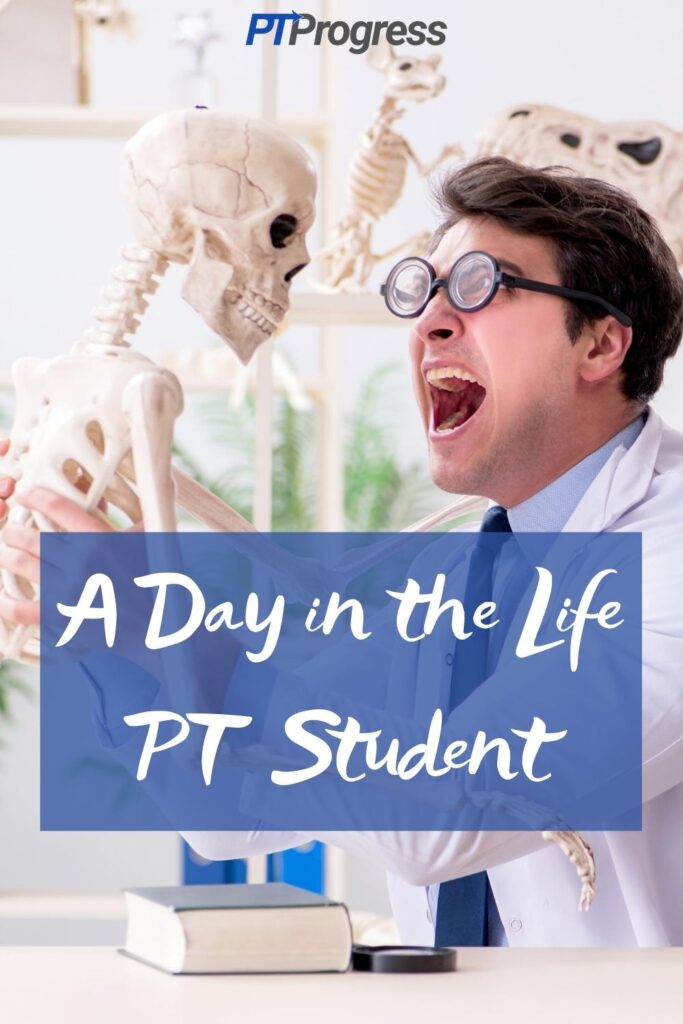
Have you wondered what it’s like to be in Physical Therapy school? What does a typical day looks like for PT students? Is school hard or is it a breeze? If so, then this article is written just for you!
What Did You Decide to Go to Physical Therapy School?
As an undergrad, I actually was a biochemistry major with a minor in French with grand plans to travel the world as a conservation biologist for National Geographic. But after graduating, I started working for a dermatologist and realized that I actually wanted to help people, especially those who were struggling with physical impairments. It tears me up seeing people limit their passions and activities because of physical ailments. So I did some research, realized that physical therapy was the perfect fit, and applied to a couple programs. A couple years later, and here I am, an official student in physical therapy!
What is Physical Therapy School Like?
Physical Therapy school is hard, but worth it.
Basically, a DPT program is rigorous and tough. Now, this will obviously vary a bit on your previous education and work history. Like I mentioned previously, I didn’t plan on attending PT school in undergrad. So, I had little to no exposure to the world of physical therapy and seriously struggled during my first semester to master all of the content, especially with courses like kinesiology and gross anatomy. But likewise, fellow classmates who knew from birth that they wanted to be PT had their troubles too.
So, don’t get discouraged if you struggle. There’s no shame in asking for help. Let me say that again for the people in the back: THERE’S NO SHAME IN ASKING FOR HELP. Reach out to your professors, classmates, upperclassmen, your mom, anyone if when you struggle.
What is a Typical Day Like in PT School?
Be prepared to be on campus from 8-5 Monday through Friday. In addition to attending typical lectures, you will have hands-on lab times most days. On top of that, you will also need to find time to practice manual skills and study outside of class.
Now, you might be thinking, “Wow, that sounds terrible. Maybe PT school isn’t a good idea.” But don’t let the rigors discourage you from attending school. While some days certainly are tough, it’s 100% worth it. Working with that first patient and seeing their eyes light up with joy after finally finding healing makes every sleepless night and long day worth it.
Physical Therapy School Classes & Schedule
You might be wondering what your class schedule will look during the first year. Here’s a brief list of foundational classes that most schools offer in the first year. *
- Kinesiology – This course heavily focuses on body kinematics and how the body moves. This is also where you’ll begin to learn basic clinical skills, like performing palpations, manual muscle tests (MMTs), goniometry measurements, hand-held dynamometry (HHD) tests, and how to properly document these measurements.
- Clinical Foundations – Get your gait belt ready because this course is all about safe patient transfers, bed mobility techniques, and fitting and appropriate uses of assistive devices. ADA requirements, important factors in the acute setting (like how to prevent pressure sores), and gait training are covered as well.
- Gross Anatomy – During this
brutalcourse, anticipate learning (what felt like) every single vein, artery, nerve, and muscle in the human body and their function. Be aware, most programs use real cadavers for dissections, so mentally prepare yourself for those sights and smells. Also, we were in lab 4x per week, so also prepare to be stinky all the time and have scrubs/old clothes that can get dirty.
- Neuroscience – Just when you thought you had anatomy down, neuroscience will swoop in to remind you just how complex the human body is. The visual system, proprioception, cranial nerves, memory & learning, motor systems, and more. You’ll know it all, down to every last pathway.
- Patient Documentation – Basically is what it sounds like: how to document what you did with the patient and if it worked. This gets submitted to insurance, so if you want to get paid, pay attention and have great therapy documentation skills!
- Physical Agents – This stimulating course is just that: stimulation of tissue to encourage healing, reduce pain, or aid muscle strengthening. Topics covered typically are hot packs, cold packs, electrical stimulation, ultrasound, and other modalities.
- Research – Research, research, research. Be prepared to dive deep into different types of statistical analyses, study design, sampling, reliability, validity, correlation, regression models, and more!
- Clinical Rotations – This will vary a bit between programs, but usually within the first year or two of school, you’ll go on your first clinical rotation. Here, you’ll finally apply all the skills you’ve learned so far with your first patients!
*FYI: most DPT programs are three years long, including summer semesters.
What Can I Do Now to Prepare for PT School?
Take Relevant Courses
Again, this will vary depending available undergraduate courses offered at your university. But if possible, I’d recommend enrolling in courses like kinesiology, research, exercise science, biomechanics, and anatomy to have a firm educational foundation. Take the time to learn as much as possible.
Also, don’t neglect those statistic and research classes. While they might feel a little useless at the time, those classes will be instrumental when new research appears. As future clinicians, it’s our job filter the good research from the bad and know what techniques will provide the highest quality of care for our patients. After all, they deserve only the best.
Gain Relevant Experience
Secondly, consider working as a physical therapy aide to gain extra clinical experience. Exposure to real world experiences in the clinic can provide a nice frame of reference as you start to take your DPT courses. If there aren’t any available PT aide positions in your area though, don’t fret. Many PTs are happy to let students shadow them. Even if it’s just a couple hours a week for a semester.
However, I recommend not waiting until the summer shadow a PT. Many students tend to wait until the summer to shadow, meaning PTs can be flooded with shadowing requests and unfortunately only have so much time and resources.
Know Thyself and Be Efficient
Thirdly, take time to learn about yourself. As I mentioned previously, PT school is tough. So, the mantra, “work smarter, not harder” definitely comes into play here. Figure out your learning style and the most efficient way for you to absorb information. Once you have that down, consider finding fellow classmates or upperclassmen who learn the same way as you and ask for tips. You can never have too many studying techniques under your belt.
Next, be open to experimenting with new ways of learning. The way you studied and learned in undergrad may be different than in PT school or might even vary within classes!
Quick Tip:
For example, in undergrad, I never used flashcards because I didn’t need to. Now, I make a Quizlet before every exam and review my flashcards whenever I have a spare moment, like standing in line at the grocery store or waiting for my burrito at the Taco Bell drive thru. I also figured out that I’m a visual learner, so I now add pictures to all of my lecture notes to solidify the content in my head.
Also, if you’re a workaholic like me, schedule breaks. It is so easy to experience burn out in school (and in the workforce after graduation). Even if you have to pencil in study breaks in your planner, do it. It is tempting to neglect your physical health, mental health, and relationships in school, but maintaining a balanced schedule is essential. The better you manage your health, the better equipped you’ll be at managing your schedule.
Develop Soft Skills
Lastly, don’t forget to work on those soft skills, like interpersonal communication and listening. While these skills might seem easy enough to master, we have to remember that, ultimately, we are creating an environment suitable that is best for the patient.
As the American Physical Therapy Association (APTA) outlines in their Clinical Practice Guideline, “Incorporating a patient’s cultural considerations, need, and goals is a necessary skill in provide best-practice care.”
If we can’t/don’t take the time to listen and really understand the needs and goals of our patients, then we aren’t providing the best possible care. This takes practice and time. So consider enrolling in professional development courses or picking up book from your local library on the topic.
Upcoming Changes to PT School…
Until now, I’ve described what a “typical” schedule looks like. However, given the current circumstances and uncertainty due to COVID-19, your first year in a DPT program may look a little different than usual. For my classmates and I, we’ve had all of our classes fully online since March of 2020 and will continue to do so until it’s safe for us to return. It’s hard, scary, and frustrating, for us and faculty. It’s also a great time to practice patience, flexibility, and adaptation, all of which are essential as physical therapists. Throughout my life, I’ve learned that there’s great power in recognizing opportunity during challenging times. So as we enter the second half of 2020, let us all renew our efforts to accept these challenges and use them to plant seeds of new growth.
This article was written by Gabrielle Kremers, a current DPT student at the University of Central Arkansas who plans to specialize in outpatient sports and orthopedics upon graduating. In her free time, she enjoys a good game of ultimate frisbee, playing board games, and finding ways to be eco-friendly.

